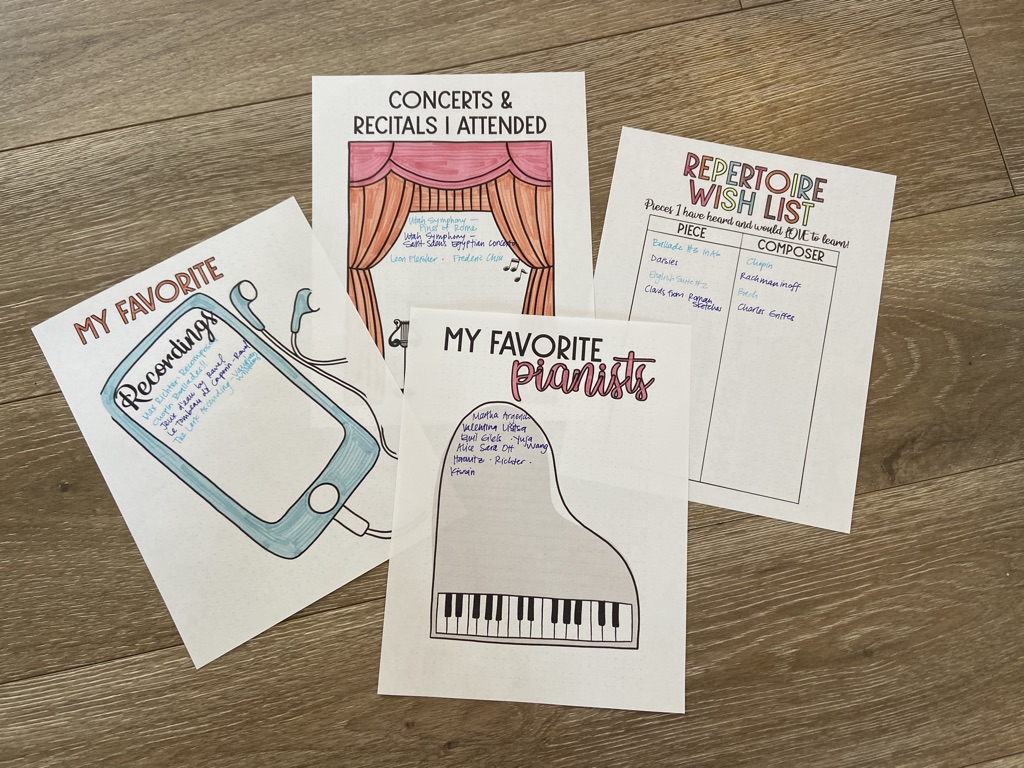I really feel very strongly about the importance of teaching our students about music and piano literature by having them actually listen to classical music.
If you asked your students who their favorite composers are, what would they say? Would they have a favorite? Would they even know enough composers to have a favorite – or know any at all? Would they look at you with a blank stare? I have gotten the whole spectrum of answers on this one, but most often it is the blank stare or “I don’t know” response.
We need to familiarize our students with the amazing works of piano literature by the great composers. We need to teach them that classical music is wonderful and amazing and really can be fun. How many of you have students who have said on occasion that they don’t like classical music? I have, and in most cases the student really has not been exposed to much classical music at all. It is our job as piano teachers to educate our students about classical music, and give them many opportunities for listening and learning.
I love using listening assignments in my studio to help my students learn about classical music. I like to assign a listening assignment at least every few weeks or so. Here are some ideas for sources of recordings:
- Awesome Website – First off, I need to share one of my FAVORITE websites of all time. Seriously if you have not seen this you need to check it out – every piano teacher should know about this awesome resource. PianoSociety.com is an AMAZING website where you can listen to and download for free thousands of mp3 recordings of piano literature by almost 200 amateur and professional pianists. They have piano literature of over 150 composers. Each composer on the site also has a brief biography and an extended biography. There is background information about all of the major works, as well. There is also a link to another site with a huge amount of classical sheet music to download. Are you still reading this? Go check it out! (But don’t forget to come back and read the rest of my post! hehe)
- Have Students Check Out CD’s – For the listening assignments I give to my students, I have made CD’s on my computer from my own classical recording library and then I loan them out to students. This works so well because I am able to create different CD’s for different composers, different musical periods, different difficulty levels, etc. Sometimes I’ll make a CD with a particular student in mind with a few pieces I’d like them to listen to. Sometimes the students’ whole family enjoys listening to their listening CD’s in the car!
- Other Websites – The San Francisco Symphony has a great kids website with a “Radio” where you can listen to lots of classical music; ClassicsForKids.com is another great site to listen to classical music; The New York Philharmonic KidZone website has an AWESOME Composer Gallery where you can learn about tons of composers and listen to some of their pieces.
Listening Assignments
When first teaching students about the different musical periods, I like to loan them a CD with one or two pieces from each period. These can be more elementary pieces that the student would most likely learn in the near future (simple Minuets, short Sonatinas, etc.), more intermediate works (Bach Inventions and easier Preludes, Clementi Sonatinas, Beethoven Sonatinas, easier Chopin Preludes and Waltzes, etc.), or you could just go for the difficult, fun-to-listen-to pieces to get them really excited about classical music! (a fun, upbeat Gigue from a Bach suite, Beethoven’s Moonlight Sonata third movement, Liszt Hungarian Rhapsodies, Rachmaninoff Preludes or Etudes, a great Impressionistic piece like Ravel’s Jeux d’Eau, etc….you get the idea!)
I often give them a handout with a brief history of piano music (which I have included below). I got this from an old teacher years ago, and I am not sure where she got it. It gives the student basic characteristics about each period, and representative composers from each period.
For any listening assignment, I like to have my students write down something they liked about each piece. It’s sometimes fun to have them rate the piece – 1 star means they didn’t really care for the piece, 5 stars means they want to learn it!
I often assign my students a CD with music of a particular composer – Debussy, Bach, Schumann, etc. I love having them get to know each composer, and hope that by doing these assignments they will be better able to actually have a favorite composer!
For young students who may not have the attention span to listen to an entire CD, I sometimes like to loan them a CD with just two or three short pieces on them. Just a couple of weeks ago I did this for a student – I made a CD with two contrasting pieces (CPE Bach’s Solfeggietto and Schumann’s Traumerei) and had him listen and write down characteristics of each piece – fast or slow, staccato or legato, loud or soft, etc. We then compared the two and talked about the differences.
I hope these ideas got you thinking about how to get our students listening to classical music. What other ideas do you use in your studio? Any other great websites we should all know about?
p.s. don’t forget to take our poll of the week!

























